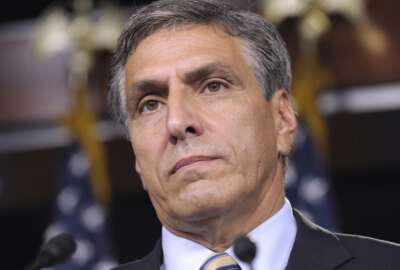Best listening experience is on Chrome, Firefox or Safari. Subscribe to Federal Drive’s daily audio interviews on Apple Podcasts or PodcastOne.
The General Services Administration wants to help agencies freeze their footprints — one million square feet at a time.
When GSA Administrator Emily Murphy first testified before the Senate for her nomination hearing, the federal government owned 372 million square feet of office space.
Today, that number is 371 million square feet.
“I want to see that number go down,” said Murphy, who testified Tuesday before a House Appropriations subcommittee on her agency’s 2019 budget request. “I’ve been meeting with each of the cabinet secretaries or their deputies to actually talk to them about their utilization rates so I can get a commitment from the top that they’re going to work with me to push those numbers down, so we can get a better value.”
Ultimately, GSA and the Trump administration say they to want to move away from leased space as the main option for federal agencies. Leased space makes up about half of the current federal footprint.
“We are making every effort to move people out of leased space and into federal buildings,” Murphy said. “I actually met with GAO, and we’re actually helping them move all their offices into federal buildings and consolidating those.”
The Transportation Department’s headquarters in Washington is one of GSA’s purchase-option priorities for 2019.
Murphy said the $768 million purchase will save taxpayers in the long run, as DoT currently rents its building for $49 million a year.
“It is a 15-year lease, and we have a purchase option we can exercise at a fair-market value,” Murphy said. “We have to notify the lessor of our intention to exercise that option so that we can achieve those savings. If not, we can pay them to extend that option, but that again means more costs for taxpayers, so that’s why it’s part of this year’s budget.”
The current site meets Transportation’s requirements, Murphy said, and GSA sees the current property as a long-term investment.
But beyond the Transportation lease purchase, 2019 could be a busy year for GSA.
GSA also wants to help agencies work through a $1.4 billion backlog of unfinished repairs and infrastructure improvements.
Specifically, GSA wants to create a new fund, the Federal Building Fund, which would let the Public Buildings Service resource construction and repair projects to the tune of $10.1 billion.
GSA is also working with agencies to identify under-utilized or vacant facilities that they can consolidate or eliminate altogether. It’s twice asked agencies to identify possible properties to sell, lease or dispose, Murphy said.
The Federal Assets Sale and Transfer Act, which Congress passed in 2016, authorized GSA to stand up a Public Buildings Reform Board to identify opportunities where agencies could trim real property inventory. The Senate must confirm the board’s chairman and congressional leadership must weigh in on the appointment of the other members. Once Congress has completed that work, the board should be ready to start consolidating federal property.
In addition, GSA proposed a one-time investment of $50 million for targeted federal workforce initiatives, which Murphy said will help “improve the federal government’s ability to recruit and retain top talent and reskill the workforce to meet 21st century needs.”
FBI headquarters gets more skepticism
Lawmakers have been and continue to be skeptics of GSA’s plan to demolish the current FBI headquarters and build a new facility in its place.
Though the 2018 omnibus didn’t include additional funding to build a new FBI headquarters, Murphy said the administration is revisiting its original budget request for 2019 since Congress approved higher spending caps.
House Financial Services and General Government Subcommittee Ranking Member Mike Quigley (D-Ill.) continued to question GSA about the decision to reverse six years of planning and contract work for a suburban site in Maryland or Virginia.
According to Murphy, FBI prized its current location on Pennsylvania Avenue because it’s close to its parent organization. It revisited its old requirements for a new headquarters decision and came to GSA with new ones.
“When the FBI came and told GSA that they believed that proximity to the Department of Justice was paramount, that changed the calculation,” Murphy said. “The other item that changed the calculation was that instead of looking for a requirement to accommodate 11,000 employees, they were now looking for an option that would accommodate just over 8,000 employees. That put the site on Pennsylvania Avenue back in play.”
Copyright
© 2024 Federal News Network. All rights reserved. This website is not intended for users located within the European Economic Area.

